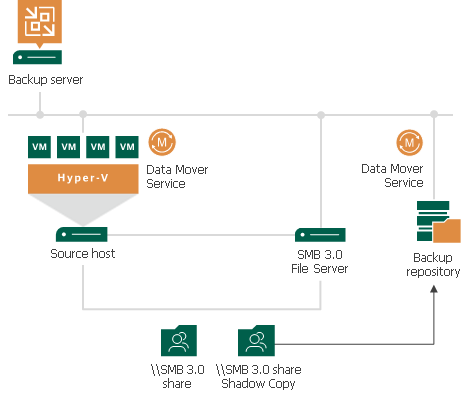无主机备份
在本页面
In general, off-host backup for VMs on SMB3 shares is similar to off-host backup of VMs on local storage or CSV. During off-host backup, Microsoft VSS processing operations are shifted from the source host to a dedicated machine — off-host backup proxy. Veeam Data Mover is deployed on the off-host backup proxy, instead of the source host.
If you want to perform off-host backup, the backup infrastructure must meet the following requirements:
- You must configure an off-host backup proxy. For more information, see Off-Host Backup Proxy.
- In the properties of a backup or replication job, you must select the off-host backup method and off-host backup proxy that you want to use. If necessary, you can point the job to a specific off-host backup proxy. For more information, see Configuring Advanced Options for Off-Host Backup Proxies.
- The LocalSystem account of the off-host backup proxy must have read access permissions on the SMB3 file share.
- The off-host backup proxy must reside in the same domain where the SMB3 server resides. Alternatively, the domain where the SMB3 server resides must trust the domain where the off-host backup proxy resides — that is, the off-host backup proxy must be located in a trusted domain.
The off-host backup process is performed in the following way:
- Veeam Backup & Replication triggers a shadow copy of the necessary file share. Microsoft VSS components invoked on the source host and SMB3 server create a shadow copy of the volume on which the requested file share is located, and expose the shadow copy as a file share on the SMB3 server.
- Veeam Data Mover on the off-host backup proxy accesses the shadow copy on the SMB3 server. It retrieves VM data from the shadow copy, processes it and copies data to the destination.
- After the backup process is complete, the shadow copy is deleted.

Related Topics